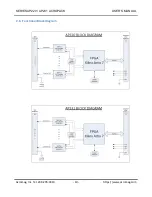
SERIES AP220 / AP231 ACROPACK
USER
’S MANUAL
Acromag, Inc. Tel: 248-295-0310
- 9 -
http://www.acromag.com
- 9 -
https://www.acromag.com
2.2 Installation Considerations
IMPORTANT: Adequate air
circulation must be provided to
prevent a temperature rise
above the maximum operating
temperature.
Refer to the specifications section for loading and power requirements. Be
sure that the system power supplies are able to accommodate the power
requirements of the system boards, plus the installed Acromag board,
within the voltage tolerances specified.
In an air cooled assembly, a minimum of 200 LFM of air circulation must be
provided to prevent a temperature rise above the maximum operating
temperature and to prolong the life of the electronics. If operating in an
ambient temperature of > 70
⁰
C a heatsink is required as well as 400 LFM of
Air circulation. If the installation is in an industrial environment and the
board is exposed to environmental air, careful consideration should be given
to air-filtering.
In a conduction cooled assembly, adequate thermal conduction must be
provided to prevent a temperature rise above the maximum operating
temperature.
2.3 Non-Isolation Considerations
The board is non-isolated, since there is electrical continuity between the
PCIe bus and AcroPack module grounds. As such, the field I/O connections
are not isolated from the system. Care should be taken in designing
installations without isolation to avoid noise pickup and ground loops
caused by multiple ground connections.
2.4 Default Hardware Configuration
A board is shipped from the factory configured as follows:
•
Internal
12 Volt power supplies are used (sourced from PCI Local
Bus connectors).
•
Analog output bipolar range is -10 to +10 Volts.
•
Software programmable register bits are undefined at reset, but the
board defaults to 0 Volts on all analog outputs and the Simultaneous
Channel Update Mode (see Section 3).
2.5 Programmable Register Configuration
Programmable registers are software configurable. That is, there are no
hardware jumpers associated with them. Registers must be accessed to
select the desired mode of operation and to update analog outputs (refer to
Section 3 for details).











































